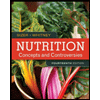
To review:
The consideration of the widespread planting of GM (genetically modified) food crops and the comfort level of a person in consuming them.
Introduction:
GM or genetically modified crops are in use for many years, still, there are many opponents of GM crops. There are various benefits and problems associated with the widespread use of such crops. Although there are no reports of problems with the GM crops yet, there might be in the near future.
Explanation of Solution
GM crops are being planted nationwide now. There are some pros and cons of this practice. They described as follows:
Pros:
1. These plants are genetically created to have characteristics like insect resistance and greater yield.
2. These plants are good for environments as lack of insecticides, toxic chemicals and fertilizers and farming equipment produce less harm to the environment.
3. The weeds are checked by these plants.
4. Reduced cost of production makes the food cheaper.
Cons:
1. There are some improvements needed for regulation criteria of GM foods by FDA (Food and Drug Administration), like random checks.
2. Organic crops are being cross-pollinated by GM crops. Some of the insects and weeds are evolved and started to overcome the GM crops.
3. GM seeds company policies are causing the farmers to spend money on seeds and raising the cost of farming.
4. Crops, if subjected to harsh conditions they are not accustomed to, entire crops may fail as they are all genetically similar and no other
Based on these points, the widespread planting of GM crops will not be advisable as if the crops fail, there will be serious consequences for the world at large. The government should make some regions GM-free so the organic crops can flourish and be available for the contingency if the GM crops fail at all.
Even though GM crops can be a problem in the future, right now there is no problem in consuming them. The GM crops are safe for consumption as there are no reported deaths, allergic reactions and medical conditions caused by them. FDA keeps monitoring the GM crops and till now have not found any discrepancy that might be lethal for humans. So far, one must not feel hesitant in consuming the products derived from these crops.
Therefore, there are certain factors that make widespread GM planting useful, but there might be problems with the GM crops in the future and these problems will be catastrophic in nature. So their wide use should be controlled. However, one can eat GM crops comfortably as they have not shown any medical hazard.
Want to see more full solutions like this?
Chapter 20 Solutions
Human Biology: Concepts and Current Issues (8th Edition)
- Can you described the image? Can you explain the question as well their answer and how to get to an answer to an problem like this?arrow_forwardglg 112 mid unit assignment Identifying melting processesarrow_forwardGive only the mode of inheritance consistent with all three pedigrees and only two reasons that support this, nothing more, (it shouldn't take too long)arrow_forward
- Oarrow_forwardDescribe the principle of homeostasis.arrow_forwardExplain how the hormones of the glands listed below travel around the body to target organs and tissues : Pituitary gland Hypothalamus Thyroid Parathyroid Adrenal Pineal Pancreas(islets of langerhans) Gonads (testes and ovaries) Placentaarrow_forward
- What are the functions of the hormones produced in the glands listed below: Pituitary gland Hypothalamus Thyroid Parathyroid Adrenal Pineal Pancreas(islets of langerhans) Gonads (testes and ovaries) Placentaarrow_forwardDescribe the hormones produced in the glands listed below: Pituitary gland Hypothalamus Thyroid Parathyroid Adrenal Pineal Pancreas(islets of langerhans) Gonads (testes and ovaries) Placentaarrow_forwardPlease help me calculate drug dosage from the following information: Patient weight: 35 pounds, so 15.9 kilograms (got this by dividing 35 pounds by 2.2 kilograms) Drug dose: 0.05mg/kg Drug concentration: 2mg/mLarrow_forward
- A 25-year-old woman presents to the emergency department with a 2-day history of fever, chills, severe headache, and confusion. She recently returned from a trip to sub-Saharan Africa, where she did not take malaria prophylaxis. On examination, she is febrile (39.8°C/103.6°F) and hypotensive. Laboratory studies reveal hemoglobin of 8.0 g/dL, platelet count of 50,000/μL, and evidence of hemoglobinuria. A peripheral blood smear shows ring forms and banana-shaped gametocytes. Which of the following Plasmodium species is most likely responsible for her severe symptoms? A. Plasmodium vivax B. Plasmodium ovale C. Plasmodium malariae D. Plasmodium falciparumarrow_forwardStandard Concentration (caffeine) mg/L Absorbance Reading 10 0.322 20 0.697 40 1.535 60 2.520 80 3.100arrow_forwardPlease draw in the missing answer, thank youarrow_forward
 Nutrition: Concepts and Controversies - Standalo...Health & NutritionISBN:9781305627994Author:Frances Sizer, Ellie WhitneyPublisher:Brooks Cole
Nutrition: Concepts and Controversies - Standalo...Health & NutritionISBN:9781305627994Author:Frances Sizer, Ellie WhitneyPublisher:Brooks Cole NutritionHealth & NutritionISBN:9781337906371Author:Sizer, Frances Sienkiewicz., WHITNEY, ElliePublisher:Cengage Learning,
NutritionHealth & NutritionISBN:9781337906371Author:Sizer, Frances Sienkiewicz., WHITNEY, ElliePublisher:Cengage Learning, Biology: The Dynamic Science (MindTap Course List)BiologyISBN:9781305389892Author:Peter J. Russell, Paul E. Hertz, Beverly McMillanPublisher:Cengage Learning
Biology: The Dynamic Science (MindTap Course List)BiologyISBN:9781305389892Author:Peter J. Russell, Paul E. Hertz, Beverly McMillanPublisher:Cengage Learning





